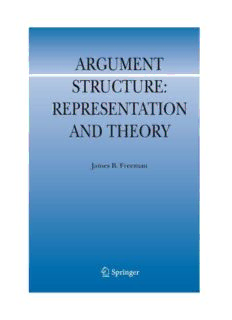Table Of ContentARGUMENTSTRUCTURE
Argumentation Library
VOLUME 18
SeriesEditors
FransH.vanEemeren,UniversityofAmsterdam,TheNetherlands
ScottJacobs,UniversityofIllinoisatUrbana-Champaign,USA
ErikC.W.Krabbe,UniversityofGroningen,TheNetherlands
JohnWoods,UniversityofBritishColumbia,Vancouver,Canada
Forfurthervolumes:
http://www.springer.com/series/5642
ARGUMENT STRUCTURE
Representation and Theory
James B. Freeman
HunterCollegeof
TheCityUniversityofNewYork,NY,USA
123
JamesB.Freeman
HunterCollege/CUNY
Philosophy
ParkAvenue695
10065NewYork
USA
[email protected]
ISSN1566-7650
ISBN978-94-007-0356-8 e-ISBN978-94-007-0357-5
DOI10.1007/978-94-007-0357-5
SpringerDordrechtHeidelbergLondonNewYork
LibraryofCongressControlNumber:2011920952
©SpringerScience+BusinessMediaB.V.2011
Nopartofthisworkmaybereproduced,storedinaretrievalsystem,ortransmittedinanyformorby
anymeans,electronic,mechanical,photocopying,microfilming,recordingorotherwise,withoutwritten
permissionfromthePublisher,withtheexceptionofanymaterialsuppliedspecificallyforthepurpose
ofbeingenteredandexecutedonacomputersystem,forexclusiveusebythepurchaserofthework.
Printedonacid-freepaper
SpringerispartofSpringerScience+BusinessMedia(www.springer.com)
FormycolleaguesinInformalLogicand
ArgumentationTheoryinGratitudefor
ManyYearsofCollaboration
Preface
These papers are a product of reflections on argument structure which I have
engaged in, on and off, for thirty years. By “structure” here I mean “macrostruc-
ture” as defined in Dialectics and the Macrostructure of Arguments (1991). We
are concerned here with how the various statements (and perhaps other elements
such as modalities and rebuttals) constituting an argument may fit together, rather
than whether a given argument instances some inference rule or pattern, such as
Modus ponens, Syllogism in Barbara, or Statistical Syllogism. I first encountered
thissenseofstructureinMonroeC.Beardsley’sThinkingStraight(1974,originally
published as Practical Logic (1950)). It struck me immediately that Beardsley’s
diagramming procedure should be a keystone of any informal logic course. How
can one properly evaluate an argument unless one sees what supports what in that
argument?
Thomas’refinementofBeardsley’sprocedureinPracticalReasoninginNatural
Language (1986, firstedition 1973) introduced distinguishinglinked fromconver-
gent argument structure–a distinction which has proved both intuitively appealing
and vexingly problematic ever since. I believe that although Thomas has identi-
fied an important distinction, he has not drawn it the right way. Substantiating
this claim and presenting, motivating, and defending a constructive alternative
which I believe draws the distinction in the right way has been an ongoing
process which has continued from my first encountering the distinction through
composing the three concluding essays for this collection. Thomas gets into dif-
ficulties, as I see it, when he speaks of the logical combination of two or more
premises. The problem is that there are two senses of “logical combination” or
“needing the others to support the conclusion” and Thomas’ specific examples
of a deductive hypothetical syllogism, an inductive statistical generalization, and
an abductive inference to best explanation conflate them. Speaking very intu-
itively or metaphorically for the present, one way in which premises logically
combine is to “pool their weight.” Each premise may give some reason for the
conclusion, but their combined weight constitutes a stronger case. We call this
modalcombination.Thomas’exampleofastatisticalgeneralizationillustratesthis
sense:
vii
viii Preface
(1) Aftereatingchocolatebar#1myfacebrokeout.
(2) Aftereatingchocolatebar#2myfacebrokeout.
.
.
.
(N) Aftereatingchocolatebar#Nmyfacebrokeout.Therefore
(C) Always,aftereatingachocolatebar,myfacebreaksout.
(Thomas 1986, 59) Obviously, this argument illustrates modal combination.
Intuitively, the higher the value of N, the stronger the argument. Although, con-
ceding that each premise “provides a little support for the conclusion,” Thomas
holds we should count this argument as linked because “the strength of support is
muchgreaterwhentheinstancesareconsideredinuniontogether,andeachreason
needsthetruthoftheothersinorderfortheconclusiontobesupported”(Thomas
1986,59).Thomas’argumentillustratinginferencetobestexplanation,
(1) Hisswimmingsuitiswet.
(2) Hishairisplastereddown.Therefore
(C) He’sbeenswimming.
(Thomas 1986, 59) again gives an instance of modal combination. Certainly,
given both premises, we should be more confident of our conclusion than if
we had just either premise alone, although each premise, by itself, gives some
evidence.
By contrast, premises which taken individually do not constitute even relevant
reasonsforaconclusion,whentakenincombinationmayconstituteoneobviously
relevantreason.Thisisrelevancecombination.Ifoneweregivenonlyonepremise
ofThomas’illustrationofahypotheticalsyllogism:
(1) Ifmarijuanawerelegalized,thenitcouldbecommerciallyprocessedandmade
availableinaformthatdidnotneedtobesmoked.
(2) If marijuana could be commercially processed and made available in a form
thatdidnotneedtobesmoked,thenitcouldbemadesaferforpeople’shealth.
Therefore
(C) Ifmarijuanawerelegalized,thenitcouldbemadesaferforpeople’shealth.
(Thomas 1986, 58) and one were totally unaware of the connection stated in the
omittedpremise,onewouldnotseewhythestatedpremisewasintuitivelyrelevant
totheconclusion.Togethertheyconstituteadeductivelystrongreasonforit.Ihold
thatpremisesinvolvingrelevancecombinationarelinked,whilepremisesinvolving
modalcombinationareconvergent.Thomasingeneralwouldcountbothaslinked,
thusconflatingrelevanceandmodalcombination.
For Thomas, in convergent arguments the premises involve no logi-
cal combination, but “each reason supports the conclusion completely sepa-
rately and independently of the other” (Thomas 1986, 60) For example, the
argument
Preface ix
➀ <Martinahasgoodscholasticaptitude.>➁ <Sheishighlymotivated.>Therefore➂ <she
willdowellacademicallyincollege.>
would be deemed convergent. But are the premises completely independent? On
relevance considerations they are. But the two premises together give a stronger
casefortheconclusionthaneitherbyitself.Intheargumenttheycombinemodally.
Without distinguishing relevance and modal combination, both the Martina argu-
ment and the argument about chocolate bars appear both linked and convergent.
Since relevance and modality are distinct issues, and premises can instance either
modal or relevance combination, one should keep these two ways of combination
distinct inan account of argument structure.Arguments are linked when premises
combineonrelevanceconsiderations.Theyareconvergentwhenthepremisesmay
combineonmodalgrounds.1
Developing a system for diagrammatically representing argument structure
adequately, which may reflect the modal/relevance distinction, is facilitated by
incorporatingsomeelementsoftheToulminmodelintoThomas’approachtocon-
structingdiagrams,whichwecallthestandardapproach.2Specifically,wemustadd
the representation of modal qualifiers to our diagramming system. Certainly in an
argument
P
1
P
2
.
.
.
P Therefore
n
ProbablyC
1In distinguishing modal and relevance combination, I have been motivated by a difference
Anderson and Belnap (1962) draw between two reasons why it is wrong to read “B →A” as
“B entails A,” when “A → (B → A)” is a theorem characterizing “→.” First, there is a prob-
lemwithnecessity.Anentailmentissupposedtobenecessarilytrue,notcontingentordependent
uponanycontingentmatteroffact.Suppose“A”isacontingentstatement.Then“A→(B→A)”
apparently asserts that the necessary statement “B →A” follows from the contingent statement
“A.”AndersonandBelnapfurtherpressthat“IfAshouldbeatruecontingentproposition,thenB
→Aisalsocontingentlytrue,andanentailmentisestablishedbecauseofanaccidentofnature”
(1962,30).“B→A”thusfailsasananalysisofentailmentongroundsofnecessity.Butnecessity,
andthusentailment,aremodalnotions.AndersonandBelnapdevelopthatrelevanceisadistinct
issuefromnecessity(andhencemodality).“B→A”canbedeficientasananalysisofentailment
ongroundsofrelevance,aswellasnecessity.If“A→(B→A)”isatheoremwhere“→”isan
allegedanalysisofentailment,and“A”isatruestatement(evenifnotcontingent),then“B→A”
istrue,evenifthereisnointuitiveconnectionofmeaningbetween“B”and“A”.But
ThatHilaryClintonwasthefirstwomantoserveasPresidentoftheUnitedStatesentails
thatforanysetsA,B,A∩B=B∩A
issimplyfalse.
2Wepresentthestandardapproachinsection2andtheToulminmodelinsection3ofChapter1,
beforeindicatingawaytointegratetheminsection4.
Description:→A is also contingently true, and an entailment is established because of an accident of nature”. (1962, 30). alleged analysis of entailment, and “A” is a true statement (even if not contingent), then “B →A” is true, even if there .. 2Adapted from David Hume, A Treatise of Human Natu

